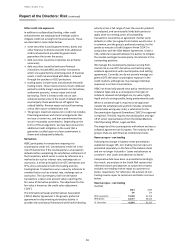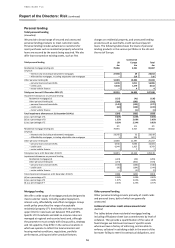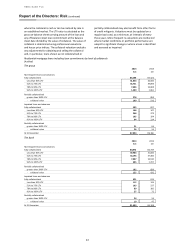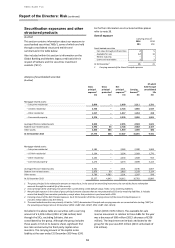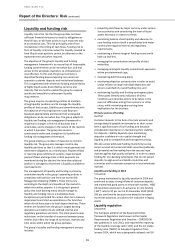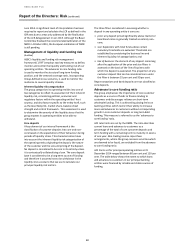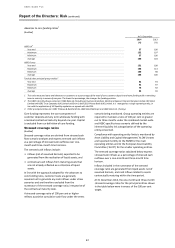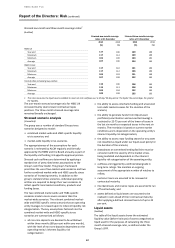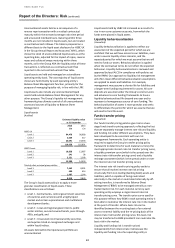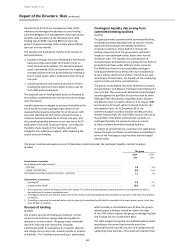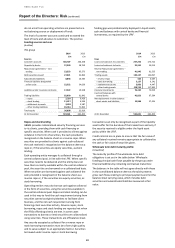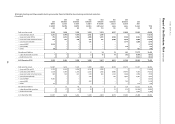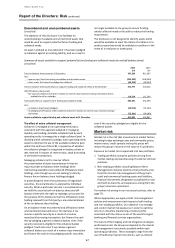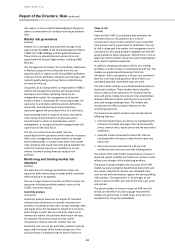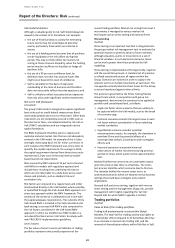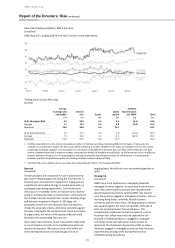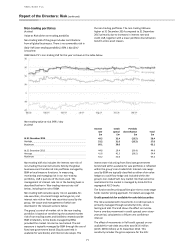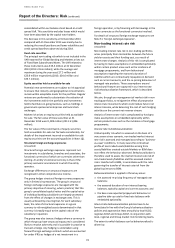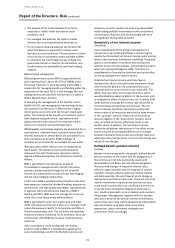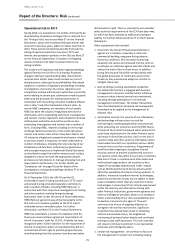HSBC 2014 Annual Report Download - page 67
Download and view the complete annual report
Please find page 67 of the 2014 HSBC annual report below. You can navigate through the pages in the report by either clicking on the pages listed below, or by using the keyword search tool below to find specific information within the annual report.
HSBC BANK PLC
Report of the Directors: Risk (continued)
65
do not arise from operating activities are presented as a
net balancing source or deployment of funds.
The level of customer accounts continued to exceed the
level of loans and advances to customers. The positive
funding gap was predominantly deployed in liquid assets;
cash and balances with central banks and financial
investments, as required by the LFRF.
Funding sources and uses
(Audited)
The group
2014
2013
2014
2013
£m
£m
£m
£m
Sources
Uses
Customer accounts
346,507
346,358
Loans and advances to customers
257,252
273,722
Deposits by banks
27,590
28,769
Loans and advances to banks
25,262
23,013
Repurchase agreements – non-
trading
23,353
65,573
Reverse Repurchase agreements –
non-trading
41,945
61,525
Debt securities issued
27,921
32,895
Trading assets
130,127
134,097
Subordinated liabilities
8,858
10,785
– reverse repos
444
5,607
Financial liabilities designated
– stock borrowing
5,137
6,241
at fair value
22,552
34,036
– settlement accounts
3,803
4,447
– other trading assets
120,743
117,802
Liabilities under insurance contracts
17,522
19,228
Financial investments
76,194
75,030
Cash and balances with
Trading liabilities
82,600
91,842
central banks
42,853
67,584
– repos
2,339
9,426
Net deployment in other balance
– stock lending
11,617
6,936
sheet assets and liabilities
19,968
27,434
– settlement accounts
3,628
3,587
– other trading liabilities
65,016
71,893
Total equity
36,698
32,919
At 31 December
593,601
662,405
At 31 December
593,601
662,405
Repos and stock lending
GB&M provides collateralised security financing services
to its clients, providing them with cash financing or
specific securities. When cash is provided to clients against
collateral in the form of securities, the cash provided is
recognised on the balance sheet as a reverse repo. When
securities are provided to clients against cash collateral
the cash received is recognised on the balance sheet as a
repo or, if the securities are equity securities, as stock
lending.
Each operating entity manages its collateral through a
central collateral pool, in line with the LFRF. When specific
securities need to be delivered and the entity does not
have them currently available within the central collateral
pool, the securities are borrowed on a collateralised basis.
When securities are borrowed against cash collateral the
cash provided is recognised on the balance sheet as a
reverse repo or, if the securities are equity securities, as
stock borrowing.
Operating entities may also borrow cash against collateral
in the form of securities, using the securities available in
the central collateral pool. Repos and stock lending can be
used in this way to fund the cash requirement arising from
securities owned outright by Markets to facilitate client
business, and the net cash requirement arising from
financing client securities activity. Reverse repos, stock
borrowing, repos and stock lending are reported net when
the IFRSs offsetting criteria are met. In some cases
transactions to borrow or lend securities are collateralised
using securities. These transactions are off-balance sheet.
Any security accepted as collateral for a reverse repo or
stock borrowing transaction must be of very high quality
and its value subject to an appropriate haircut. Securities
borrowed under reverse repo or stock borrowing
transactions can only be recognised as part of the liquidity
asset buffer for the duration of the transactions and only if
the security received is eligible under the liquid asset
policy within the LFRF.
Credit controls are in place to ensure that the fair value of
any collateral received remains appropriate to collateralise
the cash or fair value of securities given.
Wholesale term debt maturity profile
(Unaudited)
The maturity profile of the wholesale term debt
obligations is set out in the table below ‘Wholesale
funding principal cash flows payable by the group under
financial liabilities by remaining contractual maturities’.
The balances in the table will not agree directly with those
in the consolidated balance sheet as the table presents
gross cash flows relating to principal payments and not the
balance sheet carrying value, which includes debt
securities and subordinated liabilities measured at fair
value.


